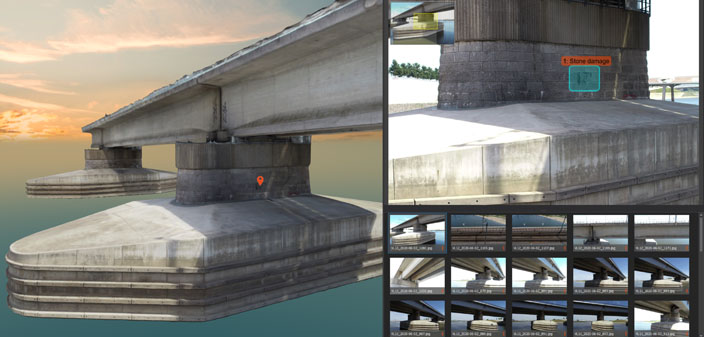Twinsity, a German-based startup with a focus on innovative software solutions for the AEC industry, has released a new tool, TwinSpect, that leverages true-to-life digital replicas for simple, efficient, and reliable virtual inspections.
Designed for infrastructure, industrial assets, telecom towers, and oil & gas, TwinSpect enables every asset stakeholder to be involved in digital and virtual inspections by focusing on easy-to-use and intuitive user experiences. Engineers, safety and maintenance staff, asset owners, contractors, or drone service providers can use TwinSpect to make work safer and more precisely while taking advantage of the opportunities offered by the digital world.
By combining ultra-high-resolution 3D models with original images of an asset, TwinSpect allows users to click on any spot in the 3D model and get the corresponding images in which this spot is visible. This way, the 3D model inside Twinsity becomes a smart navigation tool for large imagery datasets, saving a lot of time when searching the images for potential issues, as they can be identified and located much faster in the 3D model. Supporting multiple photogrammetry software to generate these 3D models, like Bentley ContextCapture and Agisoft Metashape, Twinsity recommends using Capturing Reality’s software, RealityCapture, which is a general-purpose fully-featured photogrammetry software for creating virtual reality scenes, textured and realistic 3D meshes, orthographic projections, and more from lidar, drone, or DSLR.
“Virtual asset inspections require high-quality digital replicas of the assets so that issues and interesting spots can be identified,” Fabien Chalas, Co-founder & CEO at Twinsity, said. “We are convinced that RealityCapture delivers ultra-realistic and true-to-life 3D mesh models with high-resolution textures, which makes it possible to identify every detail and issue directly in the 3D models.”
To import a RealityCapture model into TwinSpect, Twinsity created an easy and straightforward process. First, users need to export a 3D mesh model in OBJ format, and the camera alignment registration as “Internal/External camera parameters” in CSV format. The final step is to import the 3D model into Twinsity and upload the CSV file with the original images to TwinSpect.
Capturing Reality claims that “combining the power of RealityCapture with the set of tools that TwinSpect has to offer, leads to spending less time on-site allowing to conduct a large part of inspections collaboratively and remotely from the desk”. Twinsity’s new software is already being used by various companies, including PCL Construction, an American-Canadian group of general contracting construction companies, and HexCam, a UK based drone service provider.
“TwinSpect has proven to be an excellent product, but equally excellent is the support provided by the Twinsity team. They have provided some of the most responsive, timely tech support I’ve come across to get us up and running, and the unique capabilities of their solution have allowed us to offer exciting new possibilities to our clients,” commented Larry Laxdal, Virtual Construction Manager at PCL Construction.
“TwinSpect is a hugely powerful tool. It allows our clients to view large and complex data in an efficient manner, significantly decreasing the amount of time they have to spend both on and off-site.” Rowley Cory-Wright, Director at HexCam, mentioned.
Founded in 2019, Twinsity‘s focus is to allow users to interactively explore, collaborate, and share high-quality and photorealistic 3D projects. The company launched its software in late 2020, believes working digitally with 3D models opens completely new possibilities for professionals to inspect digital twins and share them with clients.
According to Chalas, the company will continue to “innovate and evolve TwinSpect to make it even more valuable for our users, such as inspection engineers and asset stakeholders. In addition to virtual inspections, we will also establish our innovative digital twins software technologies in other industries, democratizing the digitized future to a much larger audience.”









